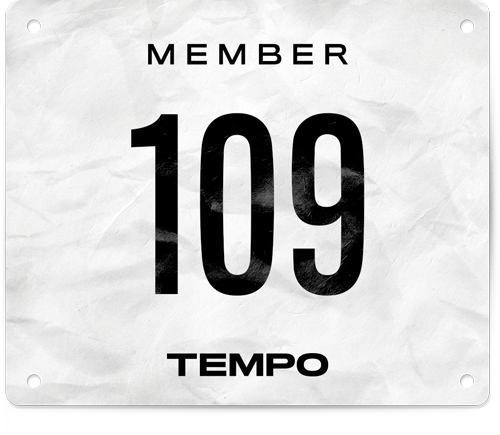Performance
Rumble Young Man, Rumble
Donavan Brazier has all the talent in the world
‘The mental image of Ali dancing was what everyone carried out onto the field where the great crowd stood up to see him arrive. Not one person in Kinshasa or the watching world, except for Ali himself, had the slightest suspicion that in the first seconds of the fight, indeed the sound of the opening bell, he would take a few flat-footed steps toward the center of the ring and then back himself into a corner - with Foreman, scarcely believing his eyes, coming swiftly in after him.’
George Plimpton
'A Date For The Dance'
Sports Illustrated, 1974
Two red tunnels with gleaming exit signs stare down onto the track at The Armory. The colonnade of windows above them gives the venue a subterranean feel, as if it’s a New York City Subway stop situated between 168th and 175th on the upper west side. Space is at a premium in the building, no different than anywhere else in Manhattan. Fans are sandwiched knee to knee to witness the 113th Millrose Games- a good chunk of the crowd there specifically to see Donavan Brazier take a shot at the American Indoor Record in the eight hundred meters. He had broken the record last year at the previous edition of this meet, finishing second to Kenyan Michael Saruni. He now held both records, indoors and out, both snatched from the smooth-striding, front-running Johnny Lee Gray Jr. a man whose name had been synonymous with American 800-meter running for over thirty years, and whose ‘hard from the gun’ style had dictated to successive generations of 800 meter runners the way to fast times.
2019 had been a storybook year for Brazier, who capped his campaign on a hot October night in Doha, Qatar by breaking Gray’s 34-year-old outdoor record en route to winning the world title -a title that neither Gray nor any other American had ever attained. Brazier became champion of the world at 22 - the same age that his idol, Muhammad Ali, first took the heavyweight title from Sonny Liston. Brazier was on top of the world, everything was peachy - except he didn’t much like getting second at Millrose, or anywhere else for that matter.
In 2018’s Millrose Games race, Don placed second to the Kenyan runner, Emmanuel Korir, trailing him by almost a full second. In 2019 he led the whole race, tucked in behind the rabbit for the first 400 meters and then out front charging against the open track before Saruni overtook him in the final 50 meters to run the second-fastest indoor 800 of all time. There are an infinite amount of lessons that can be learned from getting beat, and still more ways to implement lessons learned. Most athletes focus on the physical nature of improvement. If they are beat going hard from the gun like Johnny Gray, then they should do more strength work or shorten the rest between intervals in order to get out harder and ride the lightning a little longer, because that is how fast times are run. But fast times don’t necessarily deliver wins.
The 800m contenders entered the track from the outside through an opening in the railing at the start of the homestraight. They stepped up onto the elevated platform through a mob of people, their skin tight uniforms and lean muscular builds framed by February street clothes shaping the border of the portal to the main stage, the place where all eyes fixated. The men trotted around shaking loose their nerves and strode out around the bend, the boards from the banked track rumbling as they rolled by. The rabbit, Robert Downs, had been instructed to take the pace out in 49 seconds for the first 400 meters, a more than honest pace at the highest level of competition, and one that is only requested when someone is threatening an assault on the record books.
The athletes took a few steps to the line in their respective lanes, crouched when the order was given to ‘set’, and burst off the line as the gun fired. Downs sprinted to the front, knowing that he needed to get to the break ahead of the field so that the athletes could leave their lanes and fall in line behind him in the innermost lane. At the break, a five meter gap appeared between Downs and second place, and to the bewilderment of the crowd and field, Brazier floated back into 5th position. At 400 meters, seeing that no one was directly behind him, Downs slowed. He cruised through in 51 seconds. The world champ, still four spots behind him, came through in 53, leaving the paying customers to wonder if they’d caught him on an off day. Approaching 600 meters, the pace hadn’t quickened and the athletes had quieted any strong urges to impose their wills on the field. Veteran 800 man Eric Sowinski sat at the front, Downs having stepped off midway through the third lap. A seemingly impassable wall of Isaiah Harris and World Championship Finalist Bryce Hoppel separated Brazier from Sowinski with a little over a lap to go. Then the unthinkable happened. In a move now infamous, Brazier shifted gears in a way that would leave a transmission smoking on the side of the road, and opened up a gap enviable to anyone sitting thigh pressed squarely to thigh looking down from the stands. With a snapping back kick and high punching fists, the momentum of which glides his head forward and back like a racehorse, he entered the final straight well clear of the field. He moved so smoothly the boards didn’t even rumble as he flew by. When he crossed the line, he’d put a second and a half on second place over the final lap and- to the astonishment of all - had broken his own American Record.
“I just wanted to make a move that I knew nobody could match,” says Don. The instruction from Coach Pete Julian had been to be dead last or close to it with three hundred to two hundred meters to go, but on the straightaway before the last lap... attack. “I just sat, and I remember I never thought so much in a race. I was thinking about it every step. Can I go now? Can I go now?... I wanted to secure that 10-meter gap like right away so that leaves no room for any person trying to catch me in that last hundred meters.”
It wasn’t until Julian’s walk back to the hotel that night, scrolling through his phone and checking results, that he realized Don had broken the American Record. Brazier had executed the race according to the plan and gotten the win; that was what mattered, but he still had to reflect on what had occurred in the process. In Pete Julian’s school of training, the first and most important thing is to be the champ. Be respectful, be kind, but when you step on the track, nothing is owed to anyone, least of all a game plan. “You have to be willing to bump guys that you’re going to have dinner with later,” says Don. It increases an athlete’s odds of victory to know how to win from any part of the track, to know how to take stock of the competition and tune your effort to the distance between them and the finishing tape... and it helps to be unpredictable. It’s why there are different pitches in baseball, why poker players with telling eye twitches wear sunglasses indoors and why a trash-talking, light-footed boxer would back himself into a corner against a larger opponent with a heavier punch. One trick ponies are predictable and don’t have much of a chance if things don’t break their way.
In Pete Julian’s school of training, the first and most important thing is to be the champ. Be respectful, be kind, but when you step on the track, nothing is owed to anyone, least of all a game plan.
Donavan Brazier broke onto the national scene as a high schooler from Grand Rapids, Michigan. He proved himself to be a rare talent by ducking under the one fifty mark, the gold standard for young 800-meter men. He blasted a 1:47 at the Brooks PR Meet in Seattle his senior year before heading down to run for the Aggies of Texas A&M. While in College Station, he broke the World Indoor Junior Record his first race of the season and then broke the 50- year-old American Junior Record held by the legendary Jim Ryun en route to winning the outdoor NCAA championship. Following his freshman season, he left school and turned pro. Don bounced around to a couple different training situations, first going to work with Johnny Gray in Florida and then back with his college coach, former Grenadian 400-meter great, Alleyne Francique. Both men preached the aggressive front-running style breaking a race down to a 400-meter split, a third 200-meter split and the final 200, likely successively slower but digging the whole way.
As a younger man, Brazier thinks some of the expectations put on him by the public were unfair. The races that yielded championships and American Records were the ones when he would jump into second position from the beginning and ride until he was alone at the finish. In races where the pace was slow or varied, the outcome seemed less certain and critics were vocal. Entering the 2016 US Olympic Trials with the second fastest seed time, he failed to make the semi-final. Brazier chocks this up to youthful inexperience. “Nineteen and 20-year-olds are going to make some mistakes, and I’m not speaking like some 40-year-old that’s been through it all,” he says. “More bad crap will happen to me, but more good crap will happen to me too and it’s the ability to brush it off and learn from the good and the bad. That’s all I’ve been trying to do these past four years.” For many followers of the sport, turning pro can be a signal to having it all figured out, like skipping a grade in school. But sports are also full of examples of young talents stepping out too early and never getting their footing. With a big move, what fans want to see is if an athlete has the stomach, patience and determination to capitalize on their talent and hone their craft. This play takes time. Rare talent combined with a professional contract brings with it more eyes and more scrutiny. The attention is not unfair, but Don was a 19-year-old kid and still learning his trade. His classroom had become the mainstage and routine bumps and bruises that are part of the process would now occur in the spotlight, but no champion of the world emerges clean-faced without the scars to show for it. “The only way I could run when I was younger was just going hard from the beginning and hopefully not dying too much,” he says. “That’s such a hard way to run and it wears on your body after a while.”
"More bad crap will happen to me, but more good crap will happen to me too and it’s the ability to brush it off and learn from the good and the bad. That’s all I’ve been trying to do these past four years."
Donavan Brazier
In 2018, after achilles surgery, Don joined Pete Julian’s group, then part of the Oregon Project. Knowing that fixating on the clock can be a weakness, Pete wanted to open the canvas enough to be creative with their goals in racing situations. “Splits and data points are not really helpful to him as an athlete,” says Julian. “He needs to be able to execute a race in a different way.” Julian and Brazier began devising and executing different race plans in non-championship races Pete dubs ‘the classroom,’ in order to better prepare Don for the ones that really matter: Championships. “Pete acknowledged the kind of talent I had and the kind of artillery I had to run in different ways. We were able to finally piece together different ways to try to win races,” says Don. Little wins within each of these races where Brazier would purposely put himself in less desirable positions and free himself became just as important as the overall victory, and time was never discussed. This approach can be antithetical to many runners, who wear their times like badges, alerting others to the status they’ve achieved in the running hierarchy. In the grand scheme of things, Julian says that the most important piece of hard data defining great middle distance runners is not time, but medals and podiums. Notching a time standard serves to get a spot on the line to take a shot at the champ, but when standards are a foregone conclusion, time can be spent in the classroom mastering the art of racing.
“Pete acknowledged the kind of talent I had and the kind of artillery I had to run in different ways. We were able to finally piece together different ways to try to win races”
Donavan Brazier
All of this said, Julian believes that each athlete does have their own individual ‘position for success’. The definition of the term relates to the spot in any given landscape of a race where an athlete has the highest probability to achieve their desired outcome. Julian traces the genesis of the term to his coach, Mike Dilley. Learning to race is learning how to protect that position, and how to fight for it, and If that spot is taken, says Julian, you have to call an audible: “It’s about getting comfortable in challenging positions.”
After doing his time in the classroom in sub-optimal positions, Brazier entered the World Championship Final in Doha primed to fight for his position of success. Sizing up his opponents, he took a stab at how it would go down. “I was praying that Wesley Vasquez was going to make the final. Every single round he went gun to tape.” Betting that the “big dude” would do it again, Brazier plotted that sitting on him in second position for the first 500 meters and making a hard move down the backstretch would give him the best chance at securing the title. When the contenders left their lanes at the break, sure enough, Vasquez went to the front and Don floated across from lane four to lane one directly behind Vasquez. Through a fast opening lap under 49 seconds, the positions up front remained unchanged. Around the bend, Brazier began to creep up onto Vasquez’s shoulder, and as the curve gave way to the back straight, the high-punching, smooth-striding American from Grand Rapids stung. He overtook Vasquez on the outside and secured a five-meter gap before hitting the final curve. Alone, navigating the final 200, the question marks drifted to who would get second and third. First was secured with a knockout blow down the backstretch. Raising his fists as he crossed the line, he had become the first American to win an 800-meter world championship and had taken the American Record, doing it in a way that would make both Johnny Gray and Pete Julian proud.
After Brazier’s win at the Millrose Games in February, he and Julian decided to shut down indoor racing and gear up for the slate of outdoor meets leading up to the Olympics in Tokyo. This was before the Olympics were postponed until 2021. What lies immediately ahead of Brazier at this moment is uncertain. If there is a track season at all in 2020, it will be anything but normal, which is fine for a guy who’s trained for unpredictability. But the guy still gets the itch to rumble. Brazier is not one to make his intentions known. He will confess to never having been a goal-oriented person. He says that Olympic Gold and the World Record aren’t at the forefront of his mind. Still, something calls him back to the track.
Pete Julian has been around the sport a long time; his dad was a coach for thirty years, and he himself is a scholar of the sport cataloguing bits of information away like a Civil War historian remembers the facial hair of obscure officers. “Don was the first athlete where he’ll do stuff [in practice] and there can’t be more than one or two people on the planet that can do this. Maybe these are things that the greats- Kipketer, Rudisha - could do, but I’m not privy to it,” says Julian, adding: “He knows he’s fast.” If the purpose of gunning for times is to validate fitness and ability, what good is it when one’s ability is unquestioned? To whom does he owe that pursuit? When there are no targeted barriers or landmarks, there is only the game, and the game is played to be won by sleight of hand, fleet of foot, and a little bit of a brawling mentality. How he wants to be remembered is up to him.
“I’m going to have more bad races but I’m going to have more good races,” Don says. “When it comes down to it, I just want to win more races than I lose... And that’s hard for a middle distance runner.”
Rumble young man, rumble.


